Newsletter August 2013: Tapestry crochet, part 2: diagonal linesNews:EclatDuSoleil has designed a beautiful, lightweight crocheted shawl in two colours, Sea and Sun. This shawl is worked in laceweight bamboo in two colours. Irregular stripes give interest to the center of the shawl, and the border with its large fans adds elegance and sophistication. More information in the shop.For the knitters, Nathalie Mainsant, my very talented French translator, has decided to take up designing with the beautiful shawl Quimperlé.
This shawl is worked in laceweight bamboo in two colours. Irregular stripes give interest to the center of the shawl, and the border with its large fans adds elegance and sophistication. More information in the shop.For the knitters, Nathalie Mainsant, my very talented French translator, has decided to take up designing with the beautiful shawl Quimperlé. This shawl, worked in a single ball of the lovely wool and silk blend London, was a huge hit at the Lot et la Laine show, where it was presented in July. More information in the shop.Tapestry crochet, part 2: diagonal linesIn the last newsletter, published in June, I discussed the basics of tapestry crochet. This month, I would like to delve a bit deeper into this technique and discuss the question of diagonal lines.In my early experiments with tapestry crochet, I found one problem that really bothered me. When I tried to make, say, a diamond shape, some sides of the diamond would have nice, sharp edges and others not.Let’s have a look at a swatch where I have worked slanting colour changes in different directions.
This shawl, worked in a single ball of the lovely wool and silk blend London, was a huge hit at the Lot et la Laine show, where it was presented in July. More information in the shop.Tapestry crochet, part 2: diagonal linesIn the last newsletter, published in June, I discussed the basics of tapestry crochet. This month, I would like to delve a bit deeper into this technique and discuss the question of diagonal lines.In my early experiments with tapestry crochet, I found one problem that really bothered me. When I tried to make, say, a diamond shape, some sides of the diamond would have nice, sharp edges and others not.Let’s have a look at a swatch where I have worked slanting colour changes in different directions.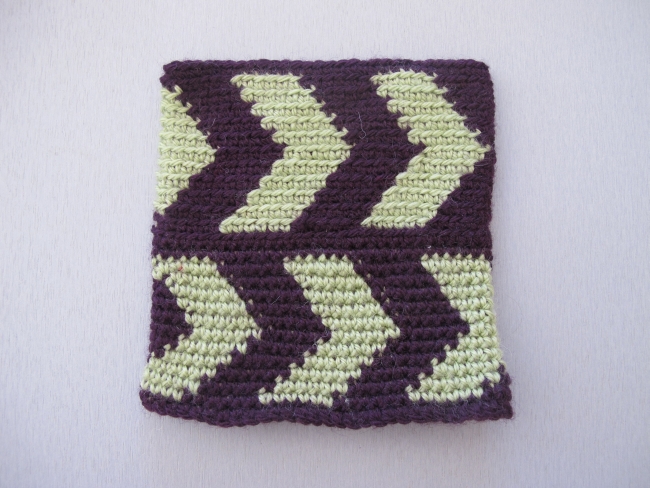 At the bottom of the swatch, I worked traditional tapestry crochet through both loops, and at the top through the back loop only. The entire swatch is worked in the round.In the bottom half, the right-slanting colour changes at the bottom look jagged, while the left-slanting lines just above look much better.When working under the back loop only, the problem is the opposite. The right-slanting colour changes look fine, but the left-slanting lines are much less neat.I set out to find a way to handle this problem without changing the basic technique (i. e., through both loops or back loop only) in the middle of the piece. It turned out that I needed two different solutions.
At the bottom of the swatch, I worked traditional tapestry crochet through both loops, and at the top through the back loop only. The entire swatch is worked in the round.In the bottom half, the right-slanting colour changes at the bottom look jagged, while the left-slanting lines just above look much better.When working under the back loop only, the problem is the opposite. The right-slanting colour changes look fine, but the left-slanting lines are much less neat.I set out to find a way to handle this problem without changing the basic technique (i. e., through both loops or back loop only) in the middle of the piece. It turned out that I needed two different solutions.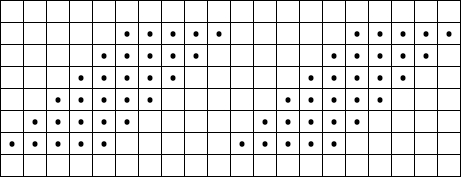 For my tests, I used a very simple pattern that, plotted out on grid paper would look as above for testing right-slanting colour changes, and as below for left-slanting ones.
For my tests, I used a very simple pattern that, plotted out on grid paper would look as above for testing right-slanting colour changes, and as below for left-slanting ones.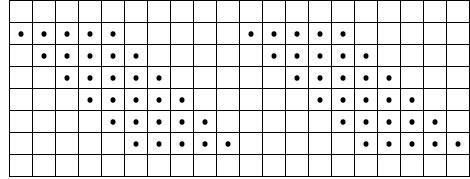 Working straight from these charts will give you jagged edges in the situations indicated above. I had to find some other method.
Working straight from these charts will give you jagged edges in the situations indicated above. I had to find some other method.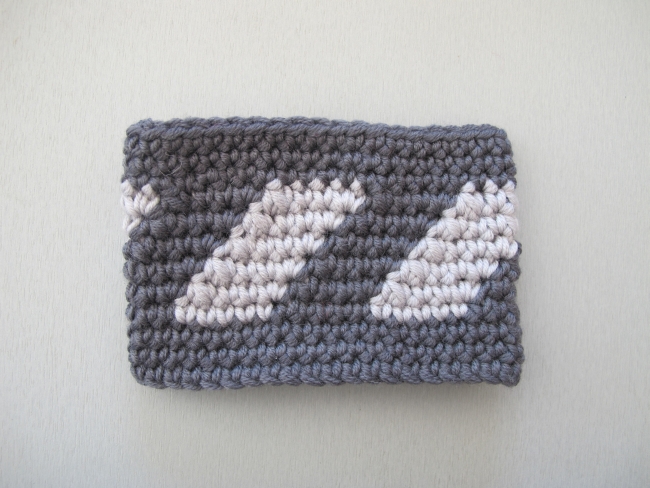 Working through both loops, I experimented my way to the following solution:Work according to the chart until 1 stitch remains before the colour change. Work sc2tog in the next two stitches (the last one in colour A and the first one in colour B according to the chart). Change colour, and work 2 sc in the second of these two stitches (the first one in colour B according to the chart). Repeat as needed.It’s true that close up and with thick yarn, as in my picture, some stitches look a bit different, especially the sc2tog before the colour change. The multiple stitches also add some bulk. However, I think that the overall impression is largely improved.
Working through both loops, I experimented my way to the following solution:Work according to the chart until 1 stitch remains before the colour change. Work sc2tog in the next two stitches (the last one in colour A and the first one in colour B according to the chart). Change colour, and work 2 sc in the second of these two stitches (the first one in colour B according to the chart). Repeat as needed.It’s true that close up and with thick yarn, as in my picture, some stitches look a bit different, especially the sc2tog before the colour change. The multiple stitches also add some bulk. However, I think that the overall impression is largely improved.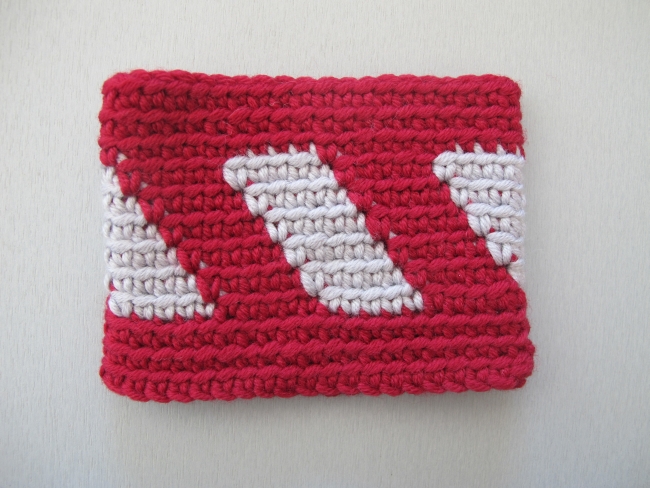 I tried to apply the same technique to a swatch worked through the back loop only, but that didn’t work at all. I had to find something else.When looking closely at my first swatch, I realized that the reason my left-slanting edges looked so uneven and jagged was that the unworked front loop in the stitch in the row below the colour change extended to the right and reached into the area of the design where I wanted only the other colour to show. From there, it was quite easy to find a technique to even out the diagonal lines. I simply worked the last stitch before each colour change under both loops. This evened out the lines considerably, as you can see in the swatch above.And what about you? Do you have any other ideas on how to even out lines at colour changes? Do let me know!
I tried to apply the same technique to a swatch worked through the back loop only, but that didn’t work at all. I had to find something else.When looking closely at my first swatch, I realized that the reason my left-slanting edges looked so uneven and jagged was that the unworked front loop in the stitch in the row below the colour change extended to the right and reached into the area of the design where I wanted only the other colour to show. From there, it was quite easy to find a technique to even out the diagonal lines. I simply worked the last stitch before each colour change under both loops. This evened out the lines considerably, as you can see in the swatch above.And what about you? Do you have any other ideas on how to even out lines at colour changes? Do let me know!
See you soon!

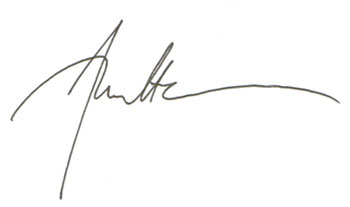
The very best answer to jagged edges I have found so far!! Now I just have to figure out how to do it…..thanks